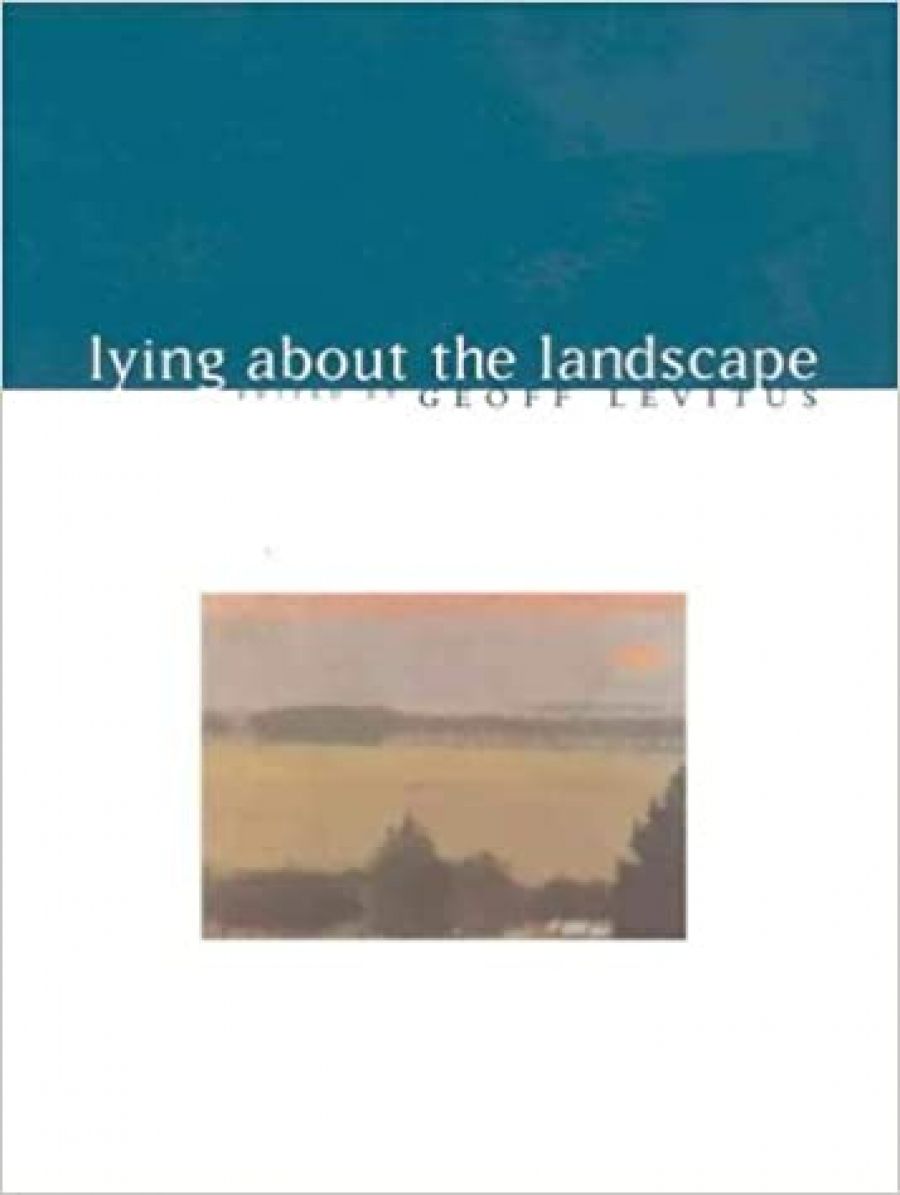
- Free Article: No
- Contents Category: Art
- Review Article: Yes
- Article Title: Myth and Landscape
- Online Only: No
- Custom Highlight Text:
The landscape has been seen (and continues to be seen) as a potent ingredient (the most potent?) in the construction of a national myth, in the determination of an identity which we can call ‘Australian’. The question of identity is a difficult area in which to delve but it is one which has elicited much critical debate and as many views as there are voices. Lying About the Landscape is exemplary of this.
- Book 1 Title: Lying About the Landscape
- Book 1 Biblio: Craftsman House $25 pb, 112 pp
Levitus’s Introduction is a rather rambling intertwining of personal reminiscence and art historical/theoretical generalisations. Nevertheless, it provides purposefully elastic parameters for the reader to engage with the (often) complex arguments and approaches to the landscape presented by the other writers. Its discursiveness is indicative of the vastness of the issues innate in any reassessment of the landscape in an Australian context.
Sue Rowley’s ‘Incidents of the Bush’ examines the possibilities of using the ‘bush landscape’ (a term which indicates the writer’s notion of varieties of landscape, or genres within the genre) as it is revealed in both visual arts and literature as a way for opening new strategies for ‘reconsidering the ... traditions of Australian national culture’. Using, for example, Frederick McCubbin’s paintings and Henry Lawson’s short stories, she eloquently charts a web of introspective and extrovert relationships and comparisons which speaks of an irresolved and layered nationalism posited on ‘multiple ... representations of land and character’.
Taking W.J.T. Mitchell’s Landscape and Power (1994) as his starting point, Terry Smith looks at the ‘Landscape School’ between the wars (although he certainly alludes to a great deal more than that). His examination of the work of ‘the bizarre modernist’ Max Meldrum, Cossington Smith and Clarice Beckett reveals the acuteness of his visual perceptions and the depth of his knowledge and understanding of Australian art in a national and international context.
Tim Bonyhady’s ‘The Ploughman’s View’ begins with an exegesis of Arthur Boyd’s ‘The colonial poet under the orange tree’, an exploration by the artist of environment being destroyed not only by the man on the land, but also by the man of culture who prefers to ignore what is happening around him. He then proceeds to a discussion of the work of Kenneth Macqueen, a prolific artist and producer of some of the finest images of his Australian landscape and an artist intimately involved with the land as a working farmer. Bonyhady’s erudition is evident in this paper which articulates the often neglected complexity of the relationship between the artist and the land.
The issue of regionalism is central to Pat Hoffie’s argument in ‘Landscape and Identity in the 1980s’. She summarises the traditional paradigms of ‘landscape as pastoral Arcadia’ (1880s) and looks to the specificity of regional relationships in a contemporary context as exemplary of critically responsive communities. The examples of Ray Arnold and David Keeling, described by Hoffie as ‘critical rather than emulative’, do little to strengthen the circumlocutory basis of her argument.
In an original and incisive essay, Sylvia Kleinert questions the privileging of ‘autonomous individual creativity’ in contemporary Aboriginal art. Through an examination of the work of Lin Onus, she offers the importance of indigenous exemplars for the development of the artist’s practice. This opens the issue of the sorts of relationships which exist between individuals and individuals and the land. The richness of these relationships in an indigenous context asserts the dynamism of Aboriginal cultures and the relevance of those cultures in any discussion of the role of landscape in the articulation of an Australian identity.
Gary Lee’s ‘Lying About the Landscape’ passionately argues the artistic dispossession of indigenous Australians by colonialism. The vehemence of his voice is a salutary comment on current issues.
The inclusion of an essay by Ian Burn is both a tragic reminder of his recent and untimely death and a paean to the depth and richness of his work (both written and pictorial) on the Australian landscape. His writing is seminal to any questions about the visualisation and theorising of the landscape. The succinct aptness of this short essay exemplifies his articulate control of his subject.
Terry Smith’s ‘Present Implications’ asserts the power of landscape to constantly emerge and re-emerge, to transcend itself as both medium and genre. The issues raised by the other writers will be important in establishing different matrices in which to (re-)evaluate the construction of our national identity and the role of landscape in that construction.
Lying About the Landscape is a timely arrival as we lurch towards the centenary of Federation. The range of views is balanced; the approaches varied, personal and articulate. Craftsman House is to be congratulated for producing this book and it is to be hoped that it becomes the first in a series that examines the issues of Australian culture rather than the personalities who populate it.


Comments powered by CComment